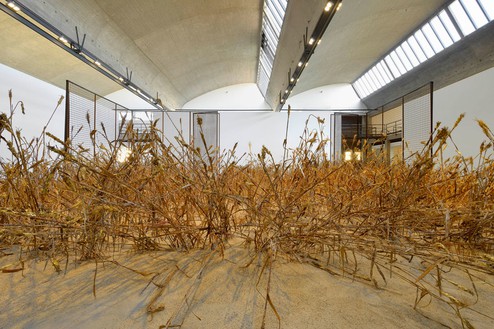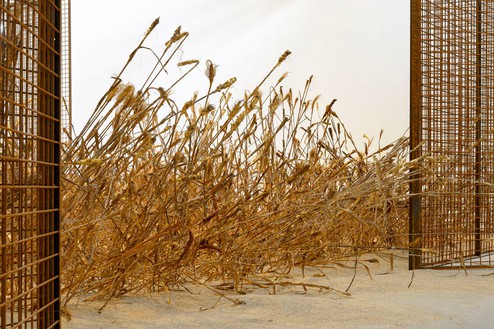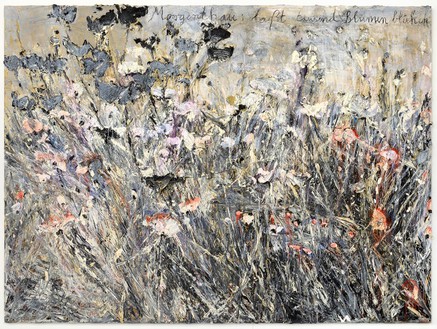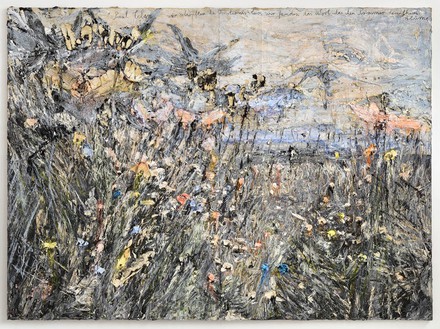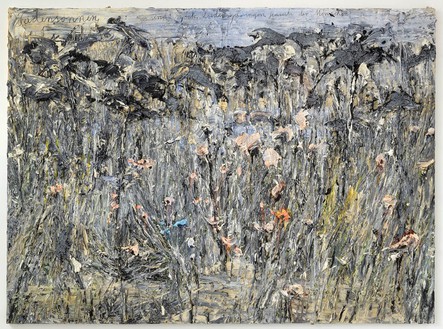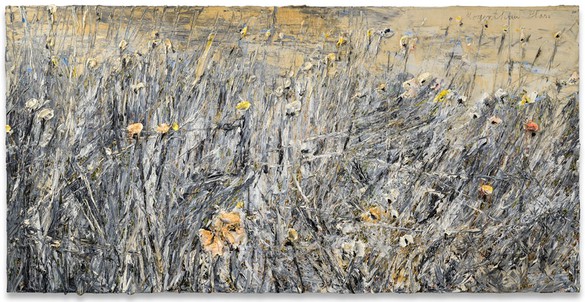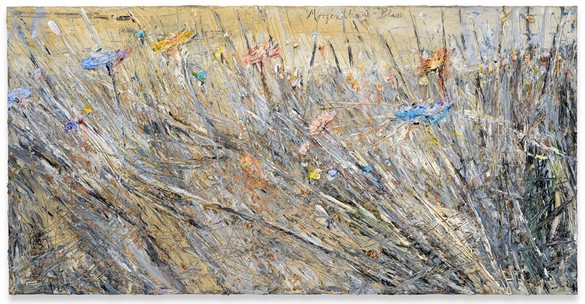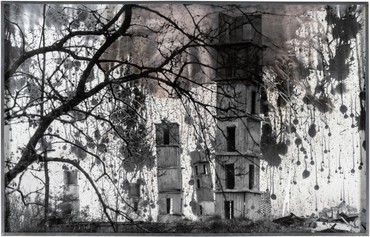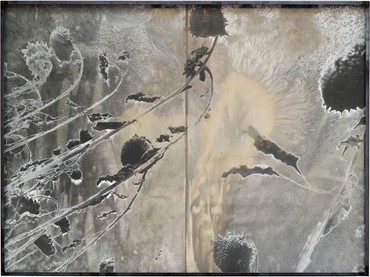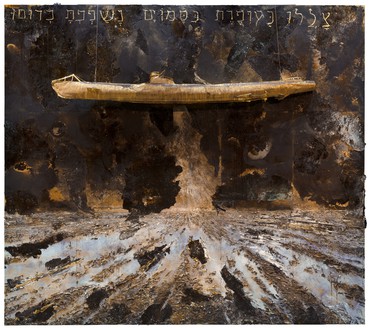About
Gagosian is pleased to inaugurate a new exhibition space at Le Bourget in the north of Paris with Morgenthau Plan, an exhibition by Anselm Kiefer. Following major exhibitions at Gagosian in New York (1998, 2000, 2002, and 2010), Los Angeles (2008), and Rome (2009), this is Kiefer’s first exhibition with the gallery in Paris.
Kiefer’s monumental archive of human memory gives overt material presence to a broad range of cultural myths and metaphors—from the Old and New Testaments, the Kabbalah, and ancient Roman history to the poetry of Ingeborg Bachmann and Paul Celan. Fusing art and literature, painting and sculpture, Kiefer engages the complex events of history and the ancestral epics of life, death, and the cosmos. He integrates, expands, and regenerates imagery and techniques, emphasizing the importance of the sacred and the spiritual.
In Morgenthau Plan, the gallery is filled with a sculpture of a golden wheat field, enclosed within a five-meter-high steel cage. Kiefer’s wheat field refers to the plan proposed in 1944 by United States Secretary of the Treasury Henry Morgenthau, Jr., to transform Germany after World War II into a pre-industrial, agricultural state thereby limiting its ability to wage war. Morgenthau sought to divide Germany into two independent states, annexing or dismantling all German centers of industry. Although the Morgenthau Plan was never realized, it represented a potential alternative German history.
Gagosian a le plaisir d’inaugurer un nouvel espace au Bourget au Nord de Paris avec Morgenthau Plan, une exposition d’Anselm Kiefer. Après des expositions majeures organisées à la Gagosian de New York (1998, 2000, 2002, et 2010), Los Angeles (2008), et Rome (2009), il s’agit de la première exposition de Kiefer à la galerie de Paris.
Les archives monumentales de Kiefer sur la mémoire humaine confèrent une présence matérielle à un large éventail de mythes culturels et de métaphores, depuis l’Ancien et le Nouveau Testament, la Kabbale, et l’histoire de la Rome antique jusqu’à la poésie d’Ingeborg Bachmann et de Paul Celan. En mêlant l’art et la littérature, la peinture et la sculpture, Kiefer éveille les événements complexes de l’histoire et les épopées ancestrales de la vie, la mort, et du cosmos. Il intègre, développe, et régénère l’imagerie et les techniques, soulignant l’importance du sacré et du spirituel.
Dans Morgenthau Plan, la galerie est occupée par une sculpture d’un champ de blé doré enfermé dans une cage en acier haute de cinq mètres. Le champ de blé de Kiefer fait référence au plan proposé en 1944 par l’ancien secrétaire américain au Trésor Henry Morgenthau, Jr., visant à transformer l’Allemagne après la Seconde Guerre Mondiale en un Etat pré-industriel, agricole et limiter ainsi ses possibilités de mener une guerre. Morgenthau cherchait à diviser l’Allemagne en deux Etats indépendants, annexer ou démanteler tous les centres allemands de l’industrie. Bien que le Plan Morgenthau n’ait jamais été réalisé, il a constitué une alternative possible à l’histoire de l’Allemagne.
Share
Artist
In Conversation
Jerome Rothenberg and Charles Bernstein
Gagosian and Beyond Baroque Literary | Arts Center hosted a conversation between poets Jerome Rothenberg and Charles Bernstein inside Anselm Kiefer’s exhibition Exodus at Gagosian at Marciano Art Foundation, Los Angeles. Rothenberg and Bernstein explored some of the themes that occupy Kiefer—Jewish mysticism, the poetry of Paul Celan, and the formulation of a global poetics in response to the Holocaust—in a discussion and readings of their poetry.
In Conversation
Anselm Kiefer and Michael Govan
On the occasion of his exhibition Anselm Kiefer: Exodus at Gagosian at Marciano Art Foundation in Los Angeles, the artist spoke with Michael Govan about his works that elaborate on themes of loss, history, and redemption.
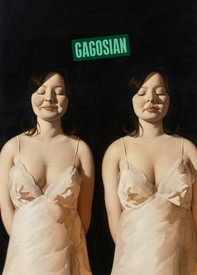
Now available
Gagosian Quarterly Winter 2022
The Winter 2022 issue of Gagosian Quarterly is now available, featuring Anna Weyant’s Two Eileens (2022) on its cover.
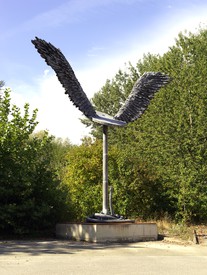
Hans Ulrich Obrist’s Questionnaire: Anselm Kiefer
In this ongoing series, curator Hans Ulrich Obrist has devised a set of thirty-seven questions that invite artists, authors, musicians, and other visionaries to address key elements of their lives and creative practices. Respondents make a selection from the larger questionnaire and reply in as many or as few words as they desire. For the fourth installment, we are honored to present the artist Anselm Kiefer.
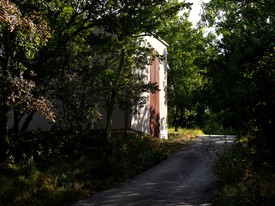
Anselm Kiefer: Architect of Landscape and Cosmology
Jérôme Sans visits La Ribaute in Barjac, France, the vast studio-estate transformed by Anselm Kiefer over the course of decades. The labyrinthine site, now open to the public, stands as a total work of art, reflecting through its grounds, pavilions, and passageways major themes in Kiefer’s oeuvre: regeneration, mythology, memory, and more.
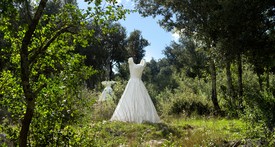
La Ribaute: Transitive, It Transforms
Camille Morineau writes of the triumph of the feminine at Anselm Kiefer’s former studio-estate in Barjac, France, describing the site and its installations as a demonstration of women’s power, a meditation on inversion and permeability, and a reversal of the long invisibility of women in history and myth.
News

Artist Spotlight
Anselm Kiefer
June 22–28, 2022
Anselm Kiefer’s monumental body of work represents a microcosm of collective memory, visually encapsulating a broad range of cultural, literary, and philosophical allusions. Drawing from sources that range from the Old and New Testaments, Kabbalah mysticism, Norse mythology, and Wagner’s Ring Cycle to the poetry of Ingeborg Bachmann and Paul Celan, Kiefer makes palpable the complexities of human history.
Photo: Georges Poncet
